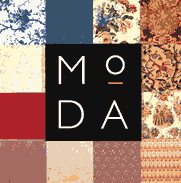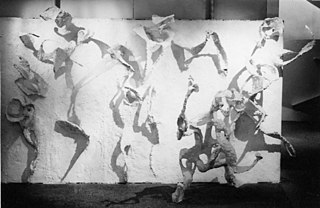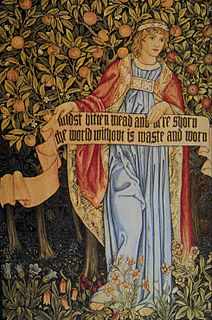Related Research Articles
Wallpaper is a material used in interior decoration to decorate the interior walls of domestic and public buildings. It is usually sold in rolls and is applied onto a wall using wallpaper paste. Wallpapers can come plain as "lining paper", textured, with a regular repeating pattern design, or, much less commonly today, with a single non-repeating large design carried over a set of sheets. The smallest rectangle that can be tiled to form the whole pattern is known as the pattern repeat.

Sir Eduardo Luigi Paolozzi was a Scottish sculptor and artist. He is widely considered to be one of the pioneers of pop art.

The Museum of Domestic Design and Architecture (MoDA) is a museum in North London, England, housing one of the most comprehensive collections of 19th- and 20th-century decorative arts for the home. The collection is designated as being of outstanding international value by Arts Council England.
The Independent Group (IG) met at the Institute of Contemporary Arts (ICA) in London, England, from 1952 to 1955. The IG consisted of painters, sculptors, architects, writers and critics who wanted to challenge prevailing modernist approaches to culture. They introduced mass culture into debates about high culture, re-evaluated modernism and created the "as found" or "found object" aesthetic. The subject of renewed interest in a post-disciplinary age, the IG was the topic of a two-day, international conference at the Tate Britain in March 2007. The Independent Group is regarded as the precursor to the Pop Art movement in Britain.

The Silver Studio was one of the most influential textile design studios in the UK from its formation in 1880 until the middle of the twentieth century.

Morris, Marshall, Faulkner & Co. (1861–1875) was a furnishings and decorative arts manufacturer and retailer founded by the artist and designer William Morris with friends from the Pre-Raphaelites. With its successor Morris & Co. (1875–1940) the firm's medieval-inspired aesthetic and respect for hand-craftsmanship and traditional textile arts had a profound influence on the decoration of churches and houses into the early 20th century.
Lawrence Reginald Alloway was an English art critic and curator who worked in the United States from 1961. In the 1950s, he was a leading member of the Independent Group in the UK and in the 1960s was an influential writer and curator in the US. He first used the term "mass popular art" in the mid-1950s and used the term "Pop Art" in the 1960s to indicate that art has a basis in the popular culture of its day and takes from it a faith in the power of images. From 1954 until his death in 1990, he was married to the painter Sylvia Sleigh.

This Is Tomorrow was an art exhibition in August 1956 at the Whitechapel Art Gallery on High Street in London, UK, facilitated by curator Bryan Robertson. The core of the exhibition was the ICA Independent Group.

Museum of Art, Rhode Island School of Design is an art museum in Providence affiliated with the Rhode Island School of Design, in the U.S. state of Rhode Island. The museum was founded in 1877 and is the 20th largest art museum in the United States.

Pallant House Gallery is an art gallery in Chichester, West Sussex, England. It houses one of the best collections of 20th century British art in the world.

John Henry Dearle was a British textile and stained-glass designer trained by the artist and craftsman William Morris who was much influenced by the Pre-Raphaelite Brotherhood. Dearle designed many of the later wallpapers and textiles released by Morris & Co., and contributed background and foliage patterns to tapestry designs featuring figures by Edward Burne-Jones and others. Beginning in his teens as a shop assistant and then design apprentice, Dearle rose to become Morris & Co.'s chief designer by 1890, creating designs for tapestries, embroidery, wallpapers, woven and printed textiles, stained glass, and carpets. Following Morris's death in 1896, Dearle was appointed Art Director of the firm, and became its principal stained glass designer on the death of Burne-Jones in 1898.

Désirée Lucienne Lisbeth Dulcie Day OBE RDI FCSD was one of the most influential British textile designers of the 1950s and 1960s. Day drew on inspiration from other arts to develop a new style of abstract pattern-making in post-war British textiles, known as ‘Contemporary’ design. She was also active in other fields, such as wallpapers, ceramics and carpets.

Landermere Wharf, sometimes called Landermere Quay, is a former dock area suitable for lying at anchor in the Tendring district of Essex, England.
Nigel Graeme Henderson (1 April 1917 - 15 May 1985) was an English documentary artist, and photographer.

Firstsite is a visual arts organisation based in Colchester, Essex, which opened in 2011.

The Minories is a Grade II listed building and gardens situated at the east end of High Street in Colchester, Essex, England, near Hollytrees, Gate House and Colchester Castle. It currently houses The Minories Galleries which are run by Colchester School of Art, part of Colchester Institute.
Marion Victoria Dorn also known as Marion Dorn Kauffer was a textile designer primarily in the form of wall hangings, carpeting and rugs, however she is also known to have produced wallpaper, graphics, and illustrations. Known for her significant contributions to modern British interiors in particular for her 'sculpted' carpets, she contributed to some of the best-known interiors of the time including the Savoy Hotel, Claridges, the Orion and the Queen Mary. In the late 1930s and early 1940s she created moquette fabric designs for use in London Transport passenger vehicles.

Henry William Collins and Joyce Millicent Pallot were two artists who lived and worked together for over 60 years. They are best known for their work on a number of large-scale public concrete murals during the 1960s and 1970s, many of which remain around the UK today. Their mural work often included elements relating to the cultural and industrial heritage of the location they were sited and is part of a tradition of muralists that includes William Mitchell and Kenneth Budd amongst others. Henry Collins and Joyce Pallot were both prominent members of the Colchester Art Society and exhibited together on a number of occasions.

Althea McNishFSCD was a British textile designer of Trinidadian origin who has been called the first British designer of African descent to earn an international reputation. Born in Trinidad, McNish moved to Britain in the 1950s. She was associated with the Caribbean Artists Movement (CAM) in the 1960s, participating in CAM's exhibitions and seminars and helping to promote Caribbean arts to a British public. Her work is represented in the collections of the Victoria and Albert Museum, the Whitworth Museum, the Philadelphia Museum of Art, the Museum of Domestic Design and Architecture and the Cooper-Hewitt, among other places.

William Morris (1834-1898), a founder of the British Arts and Crafts movement, sought to restore the prestige and methods of hand-made crafts, including textiles, in opposition to the 19th century tendency toward factory-produced textiles. With this goal in mind, he created his own workshop and designed dozens of patterns for hand-produced woven and printed cloth, upholstery, and other textiles.
References
- ↑ Michelle Cotton, 'Nigel Henderson & Eduardo Paolozzi: Hammer Prints Ltd 1954-74', firstsite, 2013
- ↑ Eduardo Paolozzi to Peter Hatch 22 August 1955, Tate Archive, reproduced in full in Robin Spencer, Eduardo Paolozzi: Writings and Interviews (Oxford University Press, Oxford, 2000) p.77-8
- ↑ Hammer Prints promotional material quoted in Victoria Walsh Parallel of Life and Art (Thames and Hudson, London 2001) p.137-8
- ↑ Judith Collins, Eduardo Paolozzi: Artificial Horizons and Eccentric Ladders, Works on Paper 1946-1995 (The British Council, London 1996) p. 48